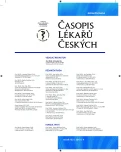Orthodontic anomalies and secular trend in formation of the orofacial cranium
Authors:
Jaroslav Racek 1; Miroslava Švábová 2; Irena Chourová 3
Authors‘ workplace:
Ústav klinické a experimentální stomatologie 1. LF UK a VFN, Praha
1; Ústav biologie a lékařské genetiky 1. LF UK a VFN, Praha
2; Soukromá ortodontická praxe, Strážné
3
Published in:
Čas. Lék. čes. 2013; 152: 192-195
Category:
Original Article
Overview
Background.
The aim of the study was to compare craniofacial and dental characteristics of contemporary and historical populations and elucidate some etiological aspects of malocclusion.
Methods and results.
Con-temporary cohort of 703 university students and three historical samples (73 skulls from 9th century, 344 skulls from the 10th to 14th century and 210 skulls from the 14th to 18th century were examined. Measurements of craniometric and anthropometric points were done. The width of jaws was examined in Pont´s points. Björk´s method for epidemiological registration of malocclusion was used; teleroentgenograms were examined as well. Broader dental arches regardless of the type of skull and significantly lower frequency of serious malocclusions were proven in historical population.
Conclusion.
The extreme increase of serious malocclusions in the contemporary population is more probably caused by civilisation factors than secular trend in formation of skull.
Keywords:
secular trend – skull measurements – maloclusion
Sources
1. Andrik P. Evolučné zmeny lebky a ich vliv na výskyt disgnácií. Folia Fac Med Univ Comenianae 1976, 14: 35–18.
2. Evensen JP, Ogaard B. Are malooclusions more prevalent and severe now? A comparative study of medieval skulls from Norway. Am J Orthod Dentofacial Orthop 2007; 131: 710–716.
3. Racek J. Nové poznatky v epidemiologii ortodontických anomálií a indikace k léčbě. Autoreferát dizertace k získání vědecké hodnosti doktora lékařských věd. Praha: Univerzita Karlova 1989.
4. Racek J, Racková-Chourová I, Koťová M, Hladíková K. Sekulární trend ve stavbě lebky a jeho vliv na utváření orofaciálního systému. Čs. Stomat. 1991; 91(2): 87–90.
5. Linsten R, Ogaard B, Larsson E. Dental arch space and permanent tooth size in the mixed dentition of a skeletal sample from the 14th to the 19th centuries and 3 contemporary samples. Am J Orthod Dentofacial Orthop 2002; 122(1): 48–58.
6. Lindsten R, Ogaard B, Larsson E, Bjerklin K. Transverse dental and dental arch depth dimensions in the mixed dentition in a skeletal sample from the 14th to the 19th century and Norwegian children and Norwegian Sami children of today. Angle Orthod 2002; 72(5): 439–448.
7. Linsten R. Secular changes in tooth size and dental arch dimensions in the mixed dentition. Swed Dent J Suppl 2003; (157): 1–89.
8. Harper C. A comparison of medieval and modern dentition. Eur L Orthod 1994; 16: 163–173.
9. Hajniš K. Anthropology of Moravian women and elderly men somatic relation of populations. Acta Universitatis Carolinae Biologica 1968, 1969.
10. Zellner K, Bach H. Zum Problem der sakularen Akzeleration von Kopfmassen bei Jeaner Schulkindern. Arztl. Jugendkd 1985; 131(1): 9–20.
11. Brůžek J, et al. Sekulární trend a debrachycefalizace českých dětí v prvním roce života. Čs. Pediat. 1988; 43(4): 199–203.
12. Little BB, Malina RM. Gene flow and variation in stature and craniofacial dimensions among indigenous populations of southern Mexico, Guatemala, and Honduras. Am J Phys Anthropol 1986; 70(4): 505–512.
13. Little BB, Buschang PH, Pena Reyes ME, Tan SK, Malina RM. Craniofacial dimensions in children in rural Oaxaca, Southern Mexico: Secular change, 1968–2000. Am J Phys Anthropol 2006; 131(1): 127–136.
14. Björk A, et al. A method for epidemiological registration of malocclusion. Acta Odont Scan 1964; 22: 28–41.
15. Racek J, Kameník K, Racková I. Kefalometrická analýza dentofaciálních charakteristik. Čs. Stomat. 1982; 82(6): 398–404.
16. Hanáková H, et al. Velkomoravské pohřebiště v Rajhradě. Národní muzeum v Praze 1986.
17. Hanáková H, Sekáčová A, Stloukal M. Pohřebiště v Ducovém, I. díl. Národní muzeum v Praze 1984.
18. Hanáková H, et al. Antropologický a stomatologický výzkum lebek z kostnice v Mělníce. Sborník Národního muzea v Praze XXXIV B, 1978(2–4): 61–90.
19. Racek J, et al. Ortodontické hodnocení kraniofaciálního skeletu z kostnice v Mělníce. In: Hanáková H, et al. Antropologický a stomatologický výzkum lebek v Mělníce. Sborník Národního muzea v Praze, XXXIV B,1978(2–4): 61–90.
20. Jaeger U, Zellner K, Kromeyer-Hauschild K, Finke L, Bruchhaus H. Is head size modified by evironmental factors? Z Morphol Anthropol 1998; 82(1): 59–66.
21. Zellner K, Jaeger U, Kromeyer-Hauschild K. The phenomenon of debrachycephalization in Jena schoolchildren. Anthropol Anz 1998; 56(4): 301–312.
22. Normando D, Faber J, Guerreiro JF, Quintao CC. Dental Occlusion in a Split Amazon Indigenous Population: Genetics Prevails over Environment. PLoS ONE 2011; 6(12): e28387.
23. Normando D, Almeida MA, Quintao CC. Dental crowding. Angle Orthod 2013; 83(1): 10–15 doi: 10.2319/02112-91.1. [Epub 2012 Jul 13].,
Labels
Addictology Allergology and clinical immunology Angiology Audiology Clinical biochemistry Dermatology & STDs Paediatric gastroenterology Paediatric surgery Paediatric cardiology Paediatric neurology Paediatric ENT Paediatric psychiatry Paediatric rheumatology Diabetology Pharmacy Vascular surgery Pain management Dental HygienistArticle was published in
Journal of Czech Physicians

Most read in this issue
- The clefts as inborn defects
- Heredity of orthodontic anomalies
- Twin studies in stomatology
- Orthodontic anomalies and secular trend in formation of the orofacial cranium
